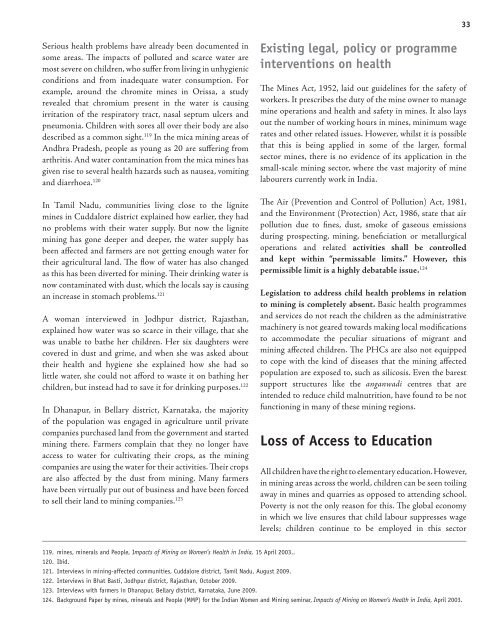Children - Terre des Hommes
Children - Terre des Hommes
Children - Terre des Hommes
Create successful ePaper yourself
Turn your PDF publications into a flip-book with our unique Google optimized e-Paper software.
33<br />
Serious health problems have already been documented in<br />
some areas. The impacts of polluted and scarce water are<br />
most severe on children, who suffer from living in unhygienic<br />
conditions and from inadequate water consumption. For<br />
example, around the chromite mines in Orissa, a study<br />
revealed that chromium present in the water is causing<br />
irritation of the respiratory tract, nasal septum ulcers and<br />
pneumonia. <strong>Children</strong> with sores all over their body are also<br />
<strong>des</strong>cribed as a common sight. In the mica mining areas of<br />
Andhra Pra<strong>des</strong>h, people as young as 20 are suffering from<br />
arthritis. And water contamination from the mica mines has<br />
given rise to several health hazards such as nausea, vomiting<br />
and diarrhoea. 120<br />
In Tamil Nadu, communities living close to the lignite<br />
mines in Cuddalore district explained how earlier, they had<br />
no problems with their water supply. But now the lignite<br />
mining has gone deeper and deeper, the water supply has<br />
been affected and farmers are not getting enough water for<br />
their agricultural land. The flow of water has also changed<br />
as this has been diverted for mining. Their drinking water is<br />
now contaminated with dust, which the locals say is causing<br />
an increase in stomach problems. 121<br />
A woman interviewed in Jodhpur district, Rajasthan,<br />
explained how water was so scarce in their village, that she<br />
was unable to bathe her children. Her six daughters were<br />
covered in dust and grime, and when she was asked about<br />
their health and hygiene she explained how she had so<br />
little water, she could not afford to waste it on bathing her<br />
children, but instead had to save it for drinking purposes. 122<br />
In Dhanapur, in Bellary district, Karnataka, the majority<br />
of the population was engaged in agriculture until private<br />
companies purchased land from the government and started<br />
mining there. Farmers complain that they no longer have<br />
access to water for cultivating their crops, as the mining<br />
companies are using the water for their activities. Their crops<br />
are also affected by the dust from mining. Many farmers<br />
have been virtually put out of business and have been forced<br />
to sell their land to mining companies. 123<br />
Existing legal, policy or programme<br />
interventions on health<br />
<br />
workers. It prescribes the duty of the mine owner to manage<br />
mine operations and health and safety in mines. It also lays<br />
out the number of working hours in mines, minimum wage<br />
rates and other related issues. However, whilst it is possible<br />
that this is being applied in some of the larger, formal<br />
sector mines, there is no evidence of its application in the<br />
small-scale mining sector, where the vast majority of mine<br />
labourers currently work in India.<br />
<br />
<br />
pollution due to fines, dust, smoke of gaseous emissions<br />
during prospecting, mining, beneficiation or metallurgical<br />
operations and related activities shall be controlled<br />
and kept within “permissable limits.” However, this<br />
permissible limit is a highly debatable issue. <br />
Legislation to address child health problems in relation<br />
to mining is completely absent. Basic health programmes<br />
and services do not reach the children as the administrative<br />
machinery is not geared towards making local modifications<br />
to accommodate the peculiar situations of migrant and<br />
mining affected children. The PHCs are also not equipped<br />
to cope with the kind of diseases that the mining affected<br />
population are exposed to, such as silicosis. Even the barest<br />
support structures like the anganwadi centres that are<br />
intended to reduce child malnutrition, have found to be not<br />
functioning in many of these mining regions.<br />
Loss of Access to Education<br />
All children have the right to elementary education. However,<br />
in mining areas across the world, children can be seen toiling<br />
away in mines and quarries as opposed to attending school.<br />
Poverty is not the only reason for this. The global economy<br />
in which we live ensures that child labour suppresses wage<br />
levels; children continue to be employed in this sector<br />
119. mines, minerals and People, Impacts of Mining on Women’s Health in India, 15 April 2003..<br />
120. Ibid.<br />
121. Interviews in mining-affected communities, Cuddalore district, Tamil Nadu, August 2009.<br />
122. Interviews in Bhat Basti, Jodhpur district, Rajasthan, October 2009.<br />
123. Interviews with farmers in Dhanapur, Bellary district, Karnataka, June 2009.<br />
124. Background Paper by mines, minerals and People (MMP) for the Indian Women and Mining seminar, Impacts of Mining on Women’s Health in India, April 2003.






